
Reservoir Dredging
Reservoir Dredging
Dredging does NOT require lowering of the lake water level or removal of fish
Dredging prevents algae and aquatic weed growth
Dredging increases the depth of your lake or around your dock
Reservoir Dredging
Reservoir Dredging
Reservoirs serve many purposes including recreation, fishing, water supply, power generation, flood control, irrigation, and navigation. Over time rivers, streams and other tributaries transport sediment into the reservoir or lake and deposit it. As the tributaries enter the reservoir the velocity of the water slows as a result of the dam and prevents the silt particles from passing through the lake. Instead the sand and silt particles settle to the bottom of the reservoir. Accumulation of sediment eventually leads to shallow or non-existent water depths. Dredging your reservoir is the only solution for removing the sediment from these areas and restoring the water depth and quality.
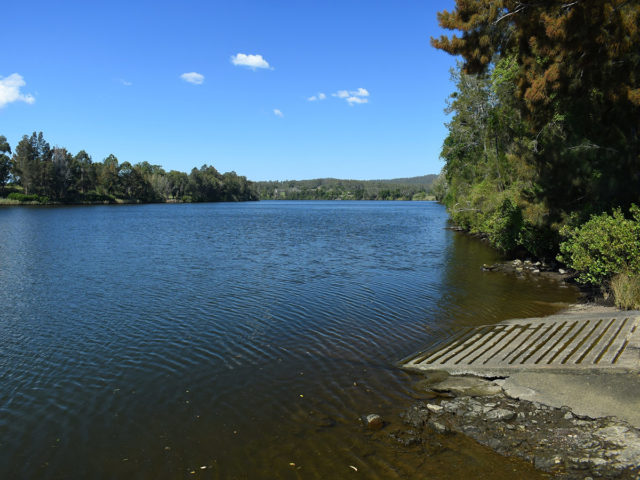
Dredging USACE, TVA, Georgia Power, and Duke Energy Reservoirs
Fortunately, dredging your reservoir does not require you to lower the water level. Often, the reservoir is controlled by entities such as the US Army Corps of Engineers (USACE), Tennessee Valley Authority (TVA), Southern Company, Georgia Power, Duke Energy, Federal Energy Regulatory Commission (FERC) or other authorities. Water levels on these reservoirs may vary with operation such as pump-storage reservoirs (i.e. Lake Oconee and Lake Sinclair), or shift with seasonal patterns for flood control (i.e. Lake Lanier and Lake Chatuge). Some reservoirs such as Lake Burton, Lake Seed, and Lake Rabun even have a drawdown period for maintenance along the shoreline, such as dredging. Regardless, of the depth of water River Sand is capable of dredging at your lake or dock within the regulations of each reservoir operator. Keep in mind that many of these regulators/operators have rules related to the timing of dredging (related to lake maintenance or fish spawning). Other dredging permits only allow for removal of silt or sediment down to the original lake bottom (hard-pan). RSI can help you navigate through each individual project’s requirements.
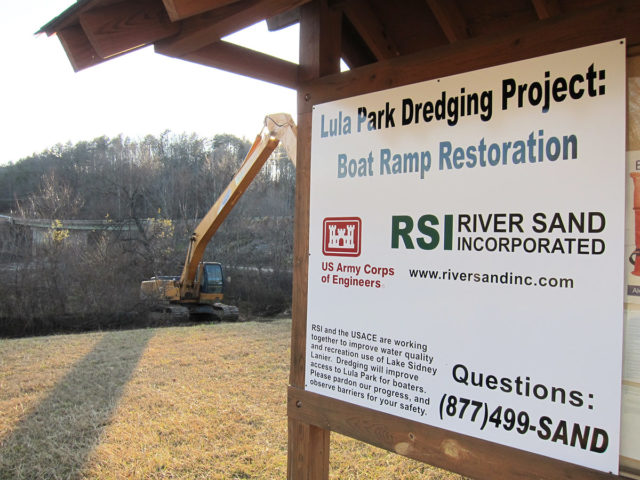
What is the process of dredging?
Dredging is the removal of silt, muck, or sediment from a body of water.
Hydraulic dredging is the use of a floating barge with a pump and cutterhead to essentially vacuum the sediment off the lake bed and pump it through a pipeline to a location. Once the slurry, which is typically 90% water and 10% sediment, reaches the end of the pipeline the water must be separated using a dewatering technique. Dewatering techniques can be a settling pond, mechanical screening, belt press, centrifuge, or a geosynthetic dewatering tube. Disposal without dewatering is unlikely because of the high volume of water with most dredges. Pumping sediment is a very efficient means to transport sediment typically within 2,000 feet of the dredge. Booster pumps can enable much further distances, up to miles of pumping, but it may not be economically feasible. An alternative process of dredging may be preferred for multiple reasons.
Mechanical dredging is the process of excavating silt or muck from a reservoir. Excavators, sometimes referred to as backhoes or trackhoes, are the most common type of dredging by excavation. Often the excavators are specialized with 2-3 time longer booms (arms) to reach further from the shore and even mounted on barges. Amphibious excavators allow for access within a lake, reservoir, or pond that contains a soft bottom or access from the shoreline or with a barge is limited. Sediment can be relayed to a disposal area with one or many excavators. Sediment can also be loaded onto a truck or barge for transport to another disposal area. Excavators along with a skilled operator are a very effective means to remove sediment from a reservoir.
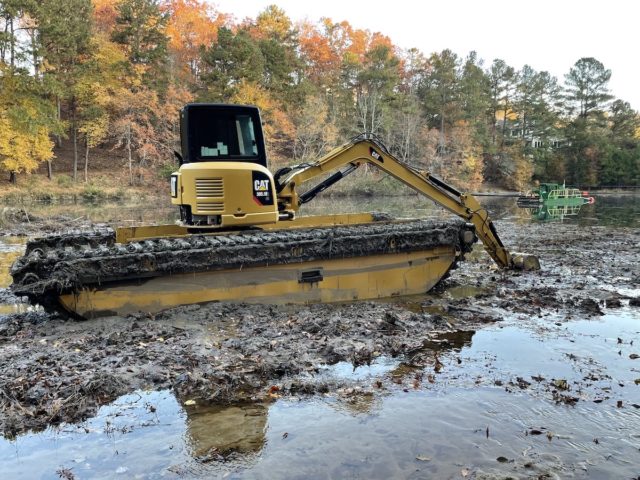
How do you dredge a dock? Can I clean the muck or sediment from my dock, boat ramp, or shoreline?
Dredging is the answer if you have muck or sediment built up under your dock, around your shoreline or boat ramp. Sediment build-up can prevent boating enthusiasts from accesing the lake via their dock or boat ramp. Often the dock is located near a tributary or shoreline erosion has contributed sediment to the water beneath the dock or near the ramp. Using your boat’s prop or propeller to maneuver through or even push the sediment out of an area is a risky alternative and could result in damage to your boat motor. Boat ramps generally provide good access for equipment to dredge the sediment and deepen the water for you to put your boat in the water. Boat docks are different with each lake, reservoir, or river. Some boat docks are floating (US Army Corps of Engineers reservoirs – i.e. Lake Lanier, Lake Hartwell) and can be temporarily moved so that you can dredge beneath the dock and place it back. Stationary docks may require a different process for cleaning beneath the dock (GA Power Lakes – i.e. Lake Burton, Lake Oconee), and small enough equipment to pump or excavate sediment beneath the dock. Regardless, River Sand has options to dredge in and around all docks. This will allow you to safely store your boat, swim off the dock, and provide water depth for a boat lift. Some dock permits with USACE even require a certain amount of water depth for a dock.
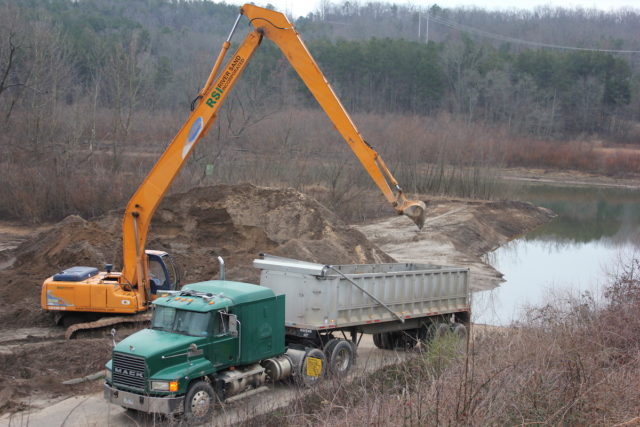
Is dredging expensive?
“What is the cost of dredging?” is probably the most common question we receive about dredging projects. It is also one of the most difficult to answer because of the factors involved to determine the cost. Many or most times these factors are unknown at the time the question is asked. The most common comparison people may be familiar with is traditional earth moving or grading projects related to construction or landscaping. Even though some of the equipment is similar, the process is different.
The cost of dredging is based largely on 4 main factors. Here are some questions to consider that you may already know, or we can help you determine:
- How much volume or quantity of sediment is there to dredge?
- What are the available points of access to the area to be dredged?
- What type of sediment or material are we dredging?
- Where will the material be disposed of?
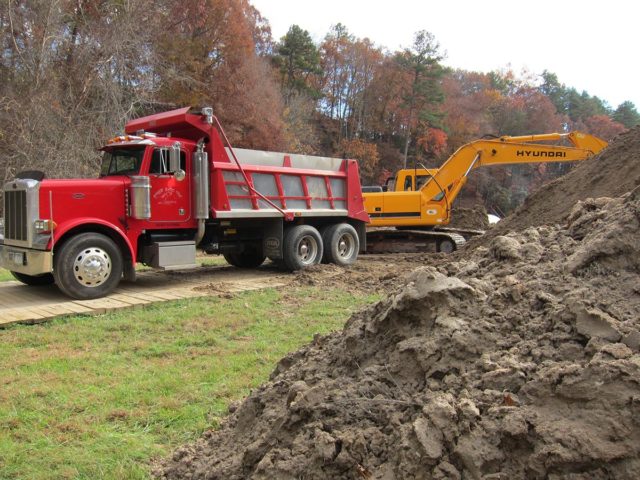
The volume or quantity of sediment to dredge is the primary factors to determine. River Sand, Inc. has dredged the smallest projects by hand with shovels and buckets all the way up to projects with millions of tons of sediment. For many projects we discuss volume of sediment or muck measured by the cubic yard as a means to determine volume. Tonnage is typically used more for water and wastewater treatment facility dredging related to wet tons or dry tons. This is not applicable to most reservoir dredging projects as the material can change dramatically in texture and type within even one small area. A bathymetric survey is one of the best methods for accurately determining the volume of sediment to dredge. River Sand offers this service to clients. The survey can measure both the top and bottom of the sediment at specific locations throughout the impacted area. Once recorded with precision GPS instruments using sub-centimeter accuracy, the data can be processed with software to determine volume, location and depths of in-situ or in place sediment. Estimates based on area and average depths can be used in planning stages or budgeting but are only useful in the initial stages for ball-park budgeting.
Access to a lake, reservoir, or pond is another consideration. Stream buffers apply to most lakes and can vary from 25-100’ from the wrested vegetation or edge of the water. Careful consideration must be taken to stay within the regulations related to stream buffers as regulated by the EPD, DEQ, or EPA. Trees, slopes, dams, and infrastructure can also impede access. For example, sewer line right of ways are often maintained and open but the owner may not allow heavy equipment to pass over the structure without permission and preventative measures from damage. Many times there is access, and even though our equipment can be large a 12-20’ path can be enough to get large machines in place. Alternatively, we have dredging equipment that can be mobilized by hand, leaving almost no footprint, and capable of removing 1,000s of cubic yards. Photos and videos as well as easement and permission from surrounding owners may be some of the questions you can help us answer. River Sand is great at finding the best solution with minimal impact.
The type of sediment to be dredged is another factor. The most common type of sediment in reservoirs is soil (dirt) and organic matter (leaves, sticks, logs). Unless there are other contamination sources within the watershed, sediment typically does not contain pollutants above EPA’s threshold contaminant levels. Many people associate all sediment with sand or sand bars but sand it usually only a portion of the material in in the lake. Sandy textured sediment may be near the inlet or mouth of the tributary/creek, but further into the lake silt sized particles are more common. Just like soil, sediment is composed of sand particles, silt particles, and clay particles. The hydrology, specifically the velocity of the water flow, determines how these sediment particles are deposited into the lake. Many times you can even visualize the layers, especially the dark organic layers from Fall leaves being deposited. Determining the type of sediment allows for the necessary dredging and dewatering methods along with developing timeframes for disposal.
The location of muck and silt disposal is a major factor in determining dredge costs. On-site disposal reduces trucking costs in many cases, and typically is preferable. Off-site disposal though is much more common because most properties are developed and graded without room for sediment placement on-site. Typically silt does not provide the characteritics for compactable fill needed for sites. In contrast, it does provide a good fill for low areas that can be re-vegetated for pasture use. Placing sediment around or on top of trees or critical root zones can be detrimental to trees and can eventually suffocate the root system, leading to tree loss. River Sand maintains multiple off-site disposal options that are permitted and suitable for different types of sediment. We also have a fleet of trucks capable of hauling wet sediment from a project. The two most common misconception related to disposal is the following:
- you can place 1,000s of cubic yards in an area that will only hold a small percentage of that (it’s hard to tell how much we are talking about when it is underwater)
- you can place sediment on a slope or gully, which leads to it not being able to remain in place or be stabilized from gravity and/or water runoff
These are the factors of dredging projects and we have had projects that range from $0.50 to $500 per cubic yard (CY). A difficult decision when providing estimated dredging costs is to provide an estimate without the factors determined and the cost being out of budget or not enough, but just remember a dredging project is not quite the same as other projects.
Dredging on Lake Lanier, Lake Burton, Lake Chatuge, Lake Hartwell, Lake Oconee, and more
River Sand, Inc. has provided dredging solutions that will work on all reservoirs in Georgia, North Carolina, and South Carolina. Our relationships and experience dredging on USACE, TVA, and Georgia Power regulated lakes goes back decades. We offer turn-key dredging solutions for your lake, boat dock, and cove regardless if the water can be lowered or not. Call us for a consultation!
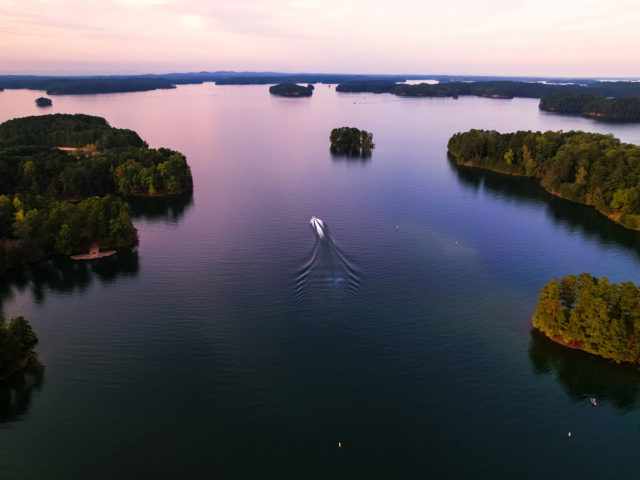
Frequently Asked Questions
Do you have questions about River Sand? We have answers!
Yes, docks are permitted to be dredged on reservoirs and lakes. However, each lake’s manager or owner has requirements of how and when a dock can be dredged. The US Army Corps of Engineers, Georgia Power, and TVA differ in requirements and dredging permits from each lake.
Yes, dredging can be performed with the water at full pool or below full pool. Dredging can be done from the shoreline or with the use of a barge.
Small hand operated dredges can be purchased for as little as $15,000, but they are only effective for limited types of projects and sediment. The smaller dredge barges can be purchased for $100,000 to $150,000. As you increase in size and effectiveness, most portable dredges cost between $500,000 and $2,000,000. The cost only increases for dredges bigger and with more features extending through the millions and for the largest dredges into the tens of millions. Auxiliary equipment and pipeline are an additional expense that needs to be considered as well in the cost of purchasing a dredge.
Dredging is highly variable in cost. Cost involved for dredging projects are typically as follows:
- Permitting – local, state, and federal are considered in most projects
- Planning – designing engineered plans usually for the dewatering area and disposal
- Mobilization – both of the equipment, the setup for dewatering, and disposal site
- Depth of Sediment – water and sediment depth determine much of the cost involved (i.e. shallow sediment depth takes much more time to dredge)
- Type of Sediment – texture of the sediment determines the type of dredge and dewatering process; debris can add to cost significantly
- Run-times – 24/7 or 5 days for 8 hours; weather is also a major factor depending on the project
- Export and Transport – the time for the dewatering (immediate vs. months) and distance to the disposal area
- Disposal – the setup of the disposal area and final reclamation; or the tip-fee for a landfill
- Remediation – clean-up of the project site and installation of best management practices
Costs to operate the dredge include wear parts, labor, fuel, and maintenance. Dredges are unique in that break-downs and maintenance usually have to occur on the water so adequate support personnel and equipment must be available. All of these factors is why dredging cost range from a $3 to $300 per cubic yard. Dredging is often limited by other factors such as dewatering or disposal, so costs can be affected by the entire process as well.
Many water treatment plants are designed to store raw water within a reservoir prior to treatment. If your reservoir is losing capacity as a result of sedimentation, dredging may be the best solution. Dredging can remove the sediment without lowering the water level, and use of NSF polymers ensure that drinking water supply continues safely. Hydraulic dredging is a preferred method to dredge the sediment while the water remains in the reservoir.
Related Articles
See what we’ve been saying about
River Sand
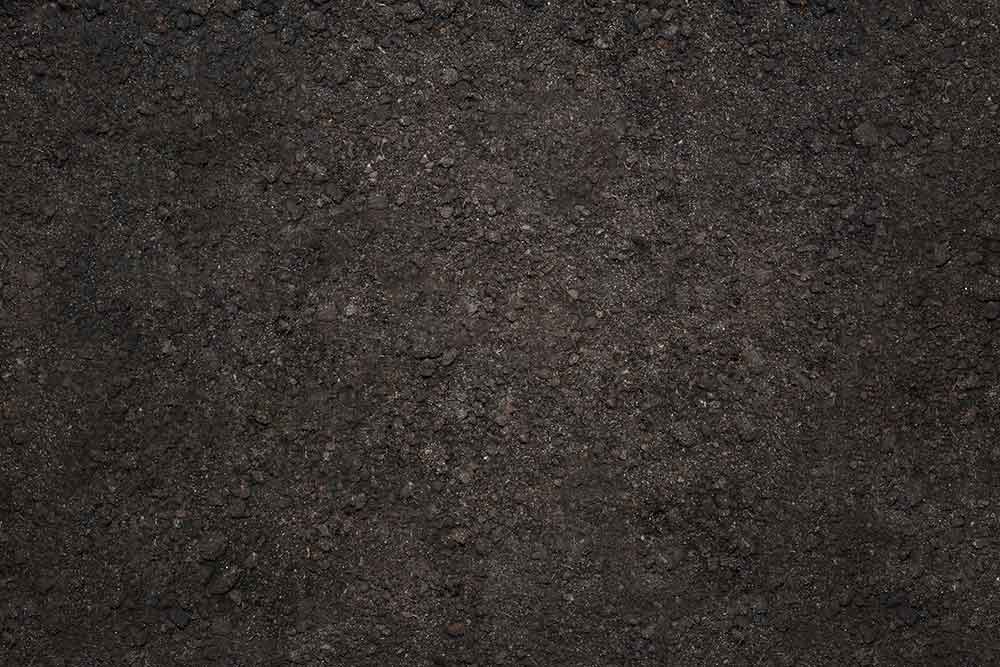
“We have used this company for many years and they have always met our expectations. Their staff is very helpful, their products are what they say they are, and the material is always delivered on time by good drivers.”
— James Laroway
Related Products
Estimate Your Dredging Project
Other projects and In-Field Mix are calculated separately.

